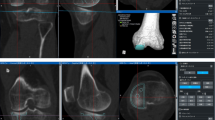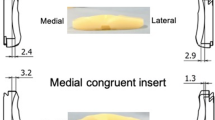Abstract
Purpose
The aim of this study was to compare the intraoperative kinematics of medial and lateral unicompartmental knee arthroplasty (UKA) with those of the native knee using a navigation system.
Methods
Six fresh-frozen cadaveric knees were included in the study. Medial UKA was performed in all right knees and lateral UKA was performed in all left knees. All UKA procedures were performed with a computerised navigation system. The tibial internal rotation angle and coronal alignment of the mechanical axis during passive knee flexion were assessed as rotational and varus/valgus kinematics before and after surgery using the navigation system.
Results
The rotation angles of the tibia in the early flexion phase of medial UKA were significantly larger than those of native knees (p = 0.008 at minimum knee flexion, p = 0.008 at 0° knee flexion). The rotational kinematics of lateral UKA was similar to those of the native knees throughout knee flexion. There were no significant differences in varus/valgus kinematics between native and UKA knees.
Conclusion
The rotational kinematics of the native knee was not restored after medial UKA but was preserved after lateral UKA. There were no significant differences in the varus/valgus kinematics after either medial or lateral UKA when compared with those of the native knees. Thus, the geometry of the medial tibial articular surface is a determinant of the ability to restore the rotational kinematics of the native knee. Surgeons and implant designers should be aware that the anatomical medial articular geometry is an important factor in restoration of the native knee kinematics after knee arthroplasty.




Similar content being viewed by others
Abbreviations
- TKA:
-
Total knee arthroplasty
- UKA:
-
Unicompartmental arthroplasty
References
Akagi M, Mori S, Nishimura S et al (2005) Variability of extraarticular tibial rotation references for total knee arthroplasty. Clin Orthop Relat Res 436:172–176
Argenson JN, Blanc G, Aubaniac JM et al (2013) Modern unicompartmental knee arthroplasty with cement. J Bone Jt Surg Am 95:905–909
Argenson JN, Komistek RD, Aubaniac JM et al (2002) In vivo determination of knee kinematics for subjects implanted with a unicompartmental arthroplasty. J Arthroplast 17:1049–1054
Asano T, Akagi M, Nakamura T (2005) The functional flexion-extension axis of the knee corresponds to the surgical epicondylar axis: in vivo analysis using a biplanar image-matching technique. J Arthroplast 20:1060–1067
Berger RA, Meneghini RM, Jacobs JJ et al (2005) Results of unicompartmental knee arthroplasty at a minimum of ten years of follow-up. J Bone Jt Surg Am 87:999–1006
Blankevoort L, Huiskes R, de Lange A (1988) The envelope of passive knee joint motion. J Biomech 21:705–720
Burn E, Sanchez-Santos MT, Pandit HG et al (2016) Ten-year patient-reported outcomes following total and minimally invasive unicompartmental knee arthroplasty: a propensity score-matched cohort analysis. Knee Surg Sport Traumatol Arthrosc. https://doi.org/10.1007/s00167-016-4404-7
Cohen J (1988) Statistical power analysis for the behavioral sciences. Lawrence Erlbaum Associates, Hillsdale
Fabre-Aubrespy M, Ollivier M, Pesenti S et al (2016) Unicompartmental knee arthroplasty in patients older than 75 results in better clinical outcomes and similar survivorship compared to total knee arthroplasty. A matched controlled study. J Arthroplast 31:2668–2671
Faul F, Erdfelder E, Lang AG, Buchner A (2007) G* Power 3: a flexible statistical power analysis program for the social, behavioral, and biomedical sciences. Behav Res Methods 39:175–191
Foran JRH, Brown NM, Della Valle CJ et al (2013) Long-term survivorship and failure modes of unicompartmental knee arthroplasty knee. Clin Orthop Relat Res 471:102–108
Hallén LG, Lindahl O (1966) The “screw-home” movement in the knee-joint. Acta Orthop Scand 37:97–106
Hamada D, Wada K, Takasago T et al (2018) Native rotational knee kinematics are lost in bicruciate-retaining total knee arthroplasty when the tibial component is replaced. Knee Surg Sport Traumatol Arthrosc. https://doi.org/10.1007/s00167-018-4842-5
Heyse TJ, El-Zayat BF, De Corte R et al (2014) UKA closely preserves natural knee kinematics in vitro. Knee Surg Sport Traumatol Arthrosc 22:1902–1910
Ishii Y, Terajima K, Terashima S et al (1997) Three-dimensional kinematics of the human knee with intracortical pin fixation. Clin Orthop Relat Res 343:144–150
Lim JW, Cousins GR, Clift BA et al (2014) Oxford unicompartmental knee arthroplasty versus age and gender matched total knee arthroplasty—functional outcome and survivorship analysis. J Arthroplast 29:1779–1783
Lisowski LA, Meijer LI, van den Bekerom MPJ et al (2016) Ten- to 15-year results of the Oxford Phase III mobile unicompartmental knee arthroplasty: a prospective study from a non-designer group. Bone Jt J 98-B:41–47
Maher JM, Markey JC, Ebert-May D (2013) The other half of the story: effect size analysis in quantitative research. CBE Life Sci Educ 12:345–351
Mochizuki T, Sato T, Blaha JD et al (2014) Kinematics of the knee after unicompartmental arthroplasty is not the same as normal and is similar to the kinematics of the knee with osteoarthritis. Knee Surg Sports Traumatol Arthrosc 22:1911–1917
Naudie D, Guerin J, Parker DA et al (2004) Medial unicompartmental knee arthroplasty with the Miller-Galante prosthesis. J Bone Jt Surg Am 86-A:1931–1935
Nishio Y, Onodera T, Kasahara Y et al (2014) Intraoperative medial pivot affects deep knee flexion angle and patient-reported outcomes after total knee arthroplasty. J Arthroplast 29:702–706
Nwachukwu BU, McCormick FM, Schairer WW et al (2014) Unicompartmental knee arthroplasty versus high tibial osteotomy: United States practice patterns for the surgical treatment of unicompartmental arthritis. J Arthroplast 29:1586–1589
Patil S, Colwell CW, Ezzet KA et al (2005) Can normal knee kinematics be restored with unicompartmental knee replacement? J Bone Jt Surg Am 87:332–338
Rajendran K (1985) Mechanism of locking at the knee joint. J Anat 143:189–194
Varadarajan KM, Zumbrunn T, Rubash HE et al (2015) Cruciate retaining implant with biomimetic articular surface to reproduce activity dependent kinematics of the normal knee. J Arthroplast 30:2149–2153
Wada K, Mikami H, Hamada D et al (2016) Measurement of rotational and coronal alignment in total knee arthroplasty using a navigation system is reproducible. Arch Orthop Trauma Surg 136:271–276
Wilson DR, Feikes JD, Zavatsky AB et al (2000) The components of passive knee movement are coupled to flexion angle. J Biomech 33:465–473
Wong T, Wang CJ, Wang JW et al (2014) Functional outcomes of uni-knee arthroplasty for medial compartment knee arthropathy in Asian patients. Biomed J 37:406
Wretenberg P, Ramsey DK, Németh G (2002) Tibiofemoral contact points relative to flexion angle measured with MRI. Clin Biomech (Bristol Avon) 17:477–485
Zuiderbaan HA, van der List JP, Khamaisy S et al (2017) Unicompartmental knee arthroplasty versus total knee arthroplasty: which type of artificial joint do patients forget? Knee Surg Sport Traumatol Arthrosc 25:681–686
Zumbrunn T, Varadarajan KM, Rubash HE et al (2015) Regaining native knee kinematics following joint arthroplasty: a novel biomimetic design with ACL and PCL preservation. J Arthroplast 30:2143–2148
Funding
No funding has been received for this study.
Author information
Authors and Affiliations
Contributions
KW carried out the kinematic measurements, performed the statistical analysis, and drafted the manuscript. DH participated in the design of the study and performed the UKA surgery. TT and AN assisted with the UKA surgery. IT and YT helped to coordinate the study. TG and KS helped to draft the manuscript. All authors read and approved the final version of the manuscript.
Corresponding author
Ethics declarations
Conflict of interest
The authors declare that they have no competing interests.
Ethical approval
All performed procedures were approved by the institutional review board of Tokushima University Hospital (the ID number of approval was 2068-1) and done in accordance with the 1964 Declaration of Helsinki and its later amendments for comparable ethical standards.
Rights and permissions
About this article
Cite this article
Wada, K., Hamada, D., Takasago, T. et al. Native rotational knee kinematics is restored after lateral UKA but not after medial UKA. Knee Surg Sports Traumatol Arthrosc 26, 3438–3443 (2018). https://doi.org/10.1007/s00167-018-4919-1
Received:
Accepted:
Published:
Issue Date:
DOI: https://doi.org/10.1007/s00167-018-4919-1




